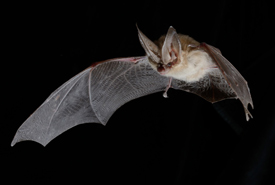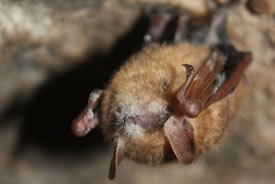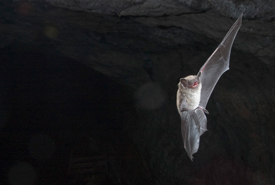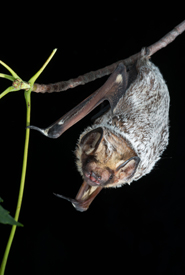Twelve spooky facts about Canadian bats

Townsend's big-eared bat (Photo by Brock Fenton)
There are 18 known bat species in Canada. Although they are subjected to a spooky stigma around Halloween, they’re nothing to be afraid of.
Here are 12 things you didn’t know about these not-so-scary mammals:
1. The snooze button
Although not all bats hibernate (some migrate), those that do, stop feeding or drinking while hibernating, and their body temperature and metabolic rates decrease markedly while in this state. This energy-efficient state allows them to sleep away the long northern winters.
2. Hanging out
Many bats hang (literally) in caves and abandoned mines during the day in summer heat or to hibernate. These sites are essential for bat populations and are often disturbed by humans.
3. Fantastic Mr. Bat
There are more than 1,300 bat species in the world. The largest species is the Pteropus bat, also known as the flying fox or fruit bat.

Tri-colored bat with white-nose syndrome (Photo by USFWS)
4. Dead ringer
White-nose syndrome is an alarming disease affecting bat populations throughout North America. In Canada, it has spread as far west as Manitoba. Scientists are looking for ways to slow or reverse the spread of this disease.
5. No Dracula sightings here
Despite the spooky tales, most bats do not drink blood — especially the species found in Canada. Only three species in the world are known to drink (animal) blood. Bats in Canada eat insects — mainly night-flying ones, as bats are typically nocturnal and forage when the sun is down.

Little brown myotis (Photo by Brock Fenton)
6. What's the buzz?
Bats are good indicators of ecosystem health and help control insect populations. Some bats can eat the equivalent of their body weight in flying insects every night.
7. Visionaries
If you’re as blind as a bat, then you’re not blind at all! Contrary to popular belief, bats can see, and some even completely rely on sight when hunting and flying. Nevertheless, most bat species find their way in the dark by emitting ultrasonic pulses of sound at objects and listening for echoes.
8. Right-wingers
The bones of a bat’s hand are elongated to support the thin double membrane of skin, which forms the wings. The scientific name for the group, Chiroptera, means "hand-wing." In most cases, there is also a membrane between the hind legs and the tail.
The membranes are also used to collect insects before they are eaten and to catch the newborn bats at birth. Some bats use their wings as raincoats, while others use them as blankets.

Hoary bat (Photo by Brock Fenton)
9. What’s up (side-down)?
How do bats hibernate without falling down? They use a special locking mechanism in their ankles that keeps their toes curled and bodies secured. It is similar to the mechanism in a horse's knee that lets it sleep while standing up. Since it is far more energy-efficient to go down than to go up, bats use gravity to start their flight. They simply uncurl the toes on their back legs, open their wings as they drop toward the ground and start to fly.
10. Old man bat
Bats are known to live a long time in the wild, some surviving more than 30 years. Nonetheless, as with many mammal species, most bats die in their first or second year of life.
11. Snowbats
Not all of Canada's bats hibernate. Much like Canadians who head south for the winter, the hoary bat, for example, migrates to the southern U.S. or Central America to escape the cold.
12. Shining the bat signal
Bats have been documented on most Nature Conservancy of Canada (NCC) properties. For example, Chase Woods in Duncan, BC, is a hot spot for these flying mammals and is known to have at least three or four bat species on the property.
NCC is doing its part to protect bat habitats like abandoned caves and helped secure the entrance of Queen Victoria Mine near Nelson, BC, to protect the bats from curious intruders.


